The Strathfield and Burwood Spitfire Fund
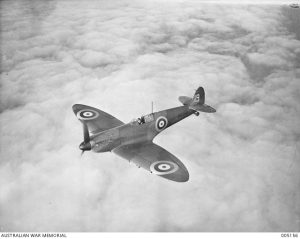
Fighter planes like this Spitfire were used to destroy enemy planes, London c. January 1941. Courtesy Australian War Memorial
Following the fall of France in June 1940, Britain found herself ill-prepared to withstand Germany’s military might – specifically the threat of the Nazi Luftwaffe bombers. The answer was the British-built Spitfire plane – and a crowdfunding campaign to pay for them. During the Battle of Britain in 1940, the Spitfire became a symbol of freedom and victory for Britain. It was light, strong and fast and its design would be upgraded as war continued. But Britain needed a lot of them and quickly. Lord Beaverbrook, newly appointed Minister of Aircraft Production encouraged a campaign to fund the building of as many Spitfires as possible with donations. Numerous funds were quickly established by community groups, councils and villages throughout Britain. Children sent their pocket money and groups invented fundraising schemes. One Spitfire was funded entirely by girls and women named Dorothy and was named ‘Dorothy of Great Britain and Empire.’ [1] Soon, other countries throughout the Empire wanted to contribute to the movement largely run by women.
The Strathfield and Burwood Spitfire Fund was established in December 1940, headed by President Emily Herron of 143 (formerly 123) The Boulevarde. The first meeting, with 100 attendees, was held in the Strathfield Town Hall where £400 was immediately raised. A letter was received from the Minister of the Army, P.C. Spender, wishing them success as well as a telegram of support from Sir Charles Marr. One attendee promised to donate £5 for every £25 received, which was a very generous undertaking.[2] The committee endeavoured to raise £6000, primarily by direct giving. Members included Miss Madeline Drayton, as Honorary Secretary, Mr R.V. Kline, Treasurer, and Vice Presidents Mrs P.D. Shortland, Miss Wise, Mrs F.A. Maguire, and Mrs W.J. Hull.[3] It was to be considered a sacrifice of the women of the district and each of the 100 ladies promised to collect subscriptions from 25 friends for the cause.[4]
By the end of 1940, 350 Spitfires a month were being produced in Britain.[5]
By February 1941 however, social activities had been added to the program of local fundraising. These included tennis tournaments as well as bridge and garden parties at local homes.[6] The entire suburbs of Strathfield and Burwood were door-knocked for subscriptions and the committee even sold miniature Spitfires for one shilling each.[7]
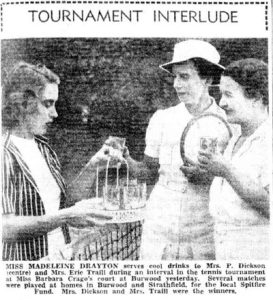
The Daily Telegraph 20 February 1941 p.11 https://trove.nla.gov.au/newspaper/article/247511744
In late March a fete was held in the three-acre garden of Vice-President Mrs J.H. Beale at Kywanna, which once stood at 20-26 Wakeford Road, Strathfield. Opened by Sir Charles and Lady Marr, the fete featured beach umbrellas, stalls, a fishing pond and bowling and croquet competitions along with afternoon tea [8] ‘served on the wide verandahs surrounding Mrs Beale’s home.’ [9] The fete raised £80 for the Fund making a total of £3000 by that time. Hostess, Rosamond Beale had only recently – and suddenly – lost her auctioneer husband, James Harrie Beale. Beale ‘was widely known in Sydney and the country as a stock auctioneer at Flemington and Homebush.’[10]
The artistic sisters Madeline and Nanette Drayton painted 12 large posters of Spitfires, each almost two metres long,[11] which were placed at strategic locations around Strathfield and Burwood. Locals were asked to cover the Spitfire with silver coins.[12] By late May the committee had raised £3750 which was cabled to British Prime Minister, Winston Churchill ‘in grateful recognition of the heroic women of Britain and Mr Churchill’s inspiring leadership.’[13] The ladies of Strathfield and Burwood noted that the sum was the result of small sacrifices by contributors and that more would follow. Churchill cabled his thanks to the ladies of Strathfield and Burwood.[14]
By June, however, the Australian government had decided that Australian money should not be sent to Britain to fund weapons – although it greatly appreciated the patriotism behind these fundraising schemes.[15] Any future funds would be used in Australia. Locally, the Strathfield and Burwood Spitfire Fund donated the extra £130 raised from a linen chest to the Red Cross groups of Strathfield and Burwood.[16]
Several Australian squadrons were formed during 1941, including Royal Australian Air Force (RAAF) Fighter Squadron No. 457, formed in England in June and equipped with Supermarine Spitfires. Initially based in southern England, it flew missions over German-occupied France between March and May 1942 before being transferred to Darwin to defend Australia from Japanese attack. Local airmen also served in these squadrons.
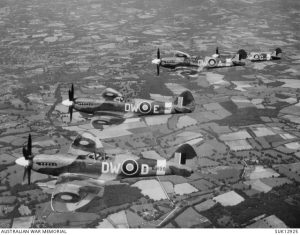
September 1944. Spitfires over England. Courtesy Australian War Memorial
John Oxley Waugh Olsson of 258 (formerly 224) Homebush Road, Strathfield South flew Spitfires with No. 453 Squadron. He was photographed in Sussex during May 1944 – the very same month that his plane was hit with flak and forced down over France. The British Wing Commodore, John Lapsley wrote to his family to say: ‘I really am most sincerely sorry that we have lost him – the Australian Squadron in my wing is composed of first-rate lads and your boy was certainly among the best of them.’[17]
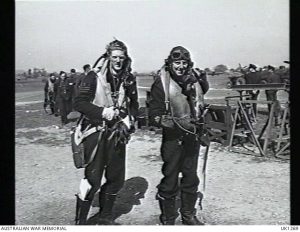
Sussex, UK. 2 May 1944 at Spitfire Fighter Bomber No.453 Squadron RAAF. 413093 Flight Sgt J.O. Olsson of Strathfield South on left.
Courtesy Australian War Memorial.
But John Olsson was one of the lucky ones. He survived his forced landing, became a prisoner of war in Germany and returned to Britain during May 1945. He died in 1990.
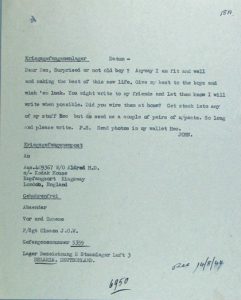
Letter from POW John Olsson to a mate. From the service record of Albert Allan Herron. Courtesy National Archives of Australia.
Incredibly, 20,341 Spitfires were built during WWII.[18] British Spitfires shot down 529 enemy aircraft during the war, losing 230 of their own.[19]
During the busy fundraising of the Strathfield and Burwood Spitfire Fund in early 1941, President Emily Herron suffered her own personal loss. At about the same time that Churchill sent his thanks to the committee for their generous donation, her own son was reported missing in Crete with the 2/1st Battalion. Defending the airfield at Retimo, the German invasion began on 20 May. Ten days later, short of ammunition and rations, the battalion was forced to surrender and became prisoners of war.[20] Lieutenant Albert Allan Herron (NX12481), aged 25, was wounded and died a prisoner of war the following day.[21] He was buried in the Phaleron War Cemetery and is also remembered on the Strathfield War Memorial.
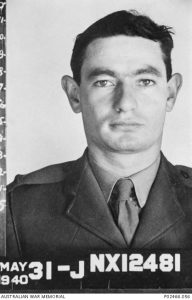
Albert Allan Herron of Strathfield. Courtesy Australian War Memorial.
In later years, the Strathfield and Burwood Spitfire Fund’s Honorary Secretary, Miss Madeline Drayton (Mrs Knizer) shared some of her wartime memories with Lucy Stone. These were published by the former Strathfield District Historical Society Newsletter in July 2001.[22]
Lest We Forget.
By J.J. MacRitchie
Local Studies Advisor
References
[1] Spitfire funds: The ‘whip-round’ that won the war? – BBC News https://www.bbc.com/news/uk-england-35697546[2] The Sun 12 December 1940 p.25 https://trove.nla.gov.au/newspaper/article/231160787
[3] Daily Telegraph 12 December 1940 p.20 https://trove.nla.gov.au/newspaper/article/248820826
[4] The Sun 17 December 1940 p.11 https://trove.nla.gov.au/newspaper/article/231152803
[5] Spitfire funds: The ‘whip-round’ that won the war? – BBC News https://www.bbc.com/news/uk-england-35697546
[6] The Daily Telegraph 20 February 1941 p.11 https://trove.nla.gov.au/newspaper/article/247511744
[7] Sydney Morning Herald 6 March 1941 p.18 https://trove.nla.gov.au/newspaper/article/17726403
[8] Sydney Morning Herald 29 March 1941 p.7 https://trove.nla.gov.au/newspaper/article/17728754
[9] The Daily Telegraph 29 March 1941 p.11 https://trove.nla.gov.au/newspaper/article/247559250
[10] Sydney Morning Herald 21 January 1941 p.15 https://trove.nla.gov.au/newspaper/article/17718836
[11] The Australian Women’s Weekly 3 May 1941 p.17 https://trove.nla.gov.au/newspaper/article/47485144
[12] Sydney Morning Herald 9 April 1941 p.27 https://trove.nla.gov.au/newspaper/article/17735681
[13] The Corowa Free Press 23 May 1941 p.3 https://trove.nla.gov.au/newspaper/article/236662813
[14] The Sun 1 June 1941 p.7 https://trove.nla.gov.au/newspaper/article/231454177
[15] The Canberra Times 9 June 1941 p.2 https://trove.nla.gov.au/newspaper/article/2559306
[16] Sydney Morning Herald 17 July 1941 p.7 https://trove.nla.gov.au/newspaper/article/17756055
[17] Olsson, John Oxley Waugh service record https://recordsearch.naa.gov.au/SearchNRetrieve/Interface/ViewImage.aspx?B=5528533Olsson
[18] Royal Air Force. Spitfire. https://www.raf.mod.uk/aircraft/spitfire/#:~:text=About%20the%20Spitfire,Battle%20of%20Britain%20Memorial%20Flight.
[19] Imperial War Museum. 9 Iconic Aircraft from the Battle of Britain. https://www.iwm.org.uk/history/9-iconic-aircraft-from-the-battle-of-britain
[20] Australian War Memorial. 2/1st Australian Infantry Battalion https://www.awm.gov.au/collection/U56044
[21] NSW. May 1940. Paybook photograph of NX12481 Lieutenant Albert Allan Herron, 2/1st Battalion, … | Australian War Memorial (awm.gov.au) https://www.awm.gov.au/collection/C335316
[22] Strathfield Heritage. Stone, Lucy ‘Reminiscing War Time Strathfield’ https://strathfieldheritage.com/people/memories-oral-history/reminiscing-war-time-strathfield/
